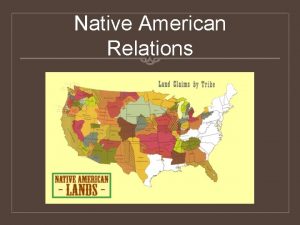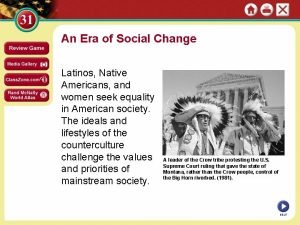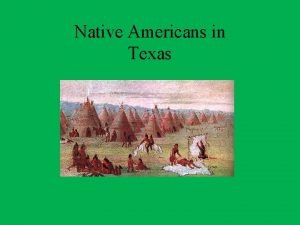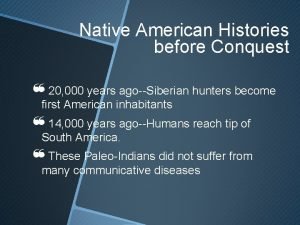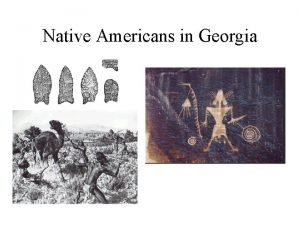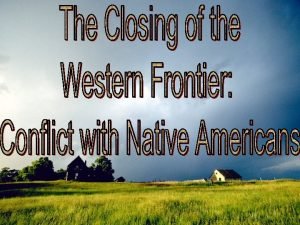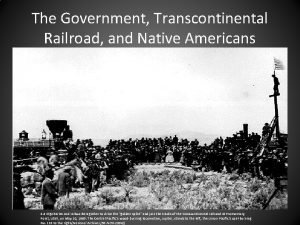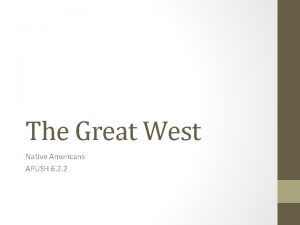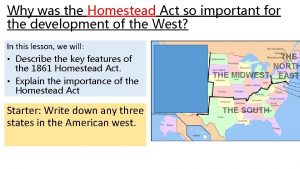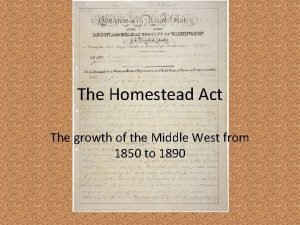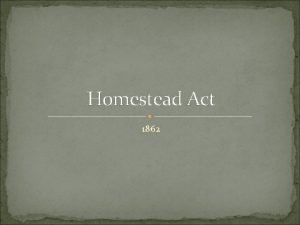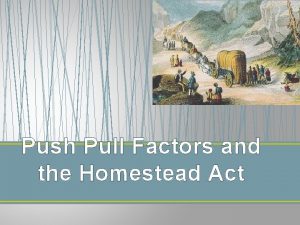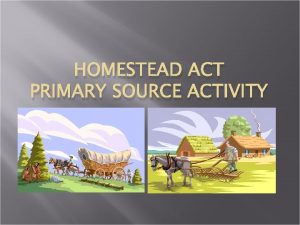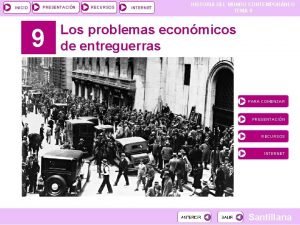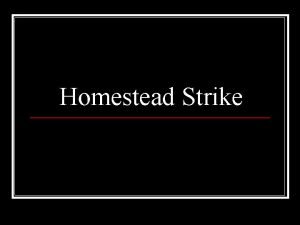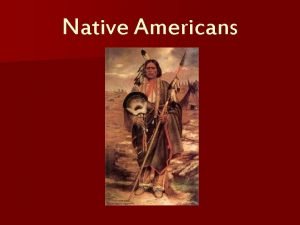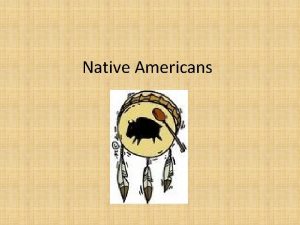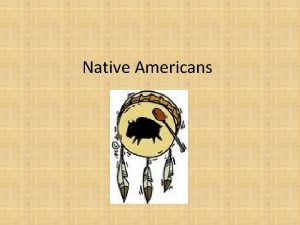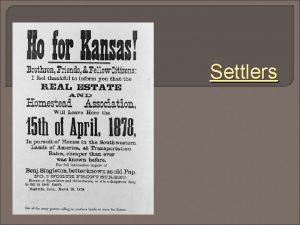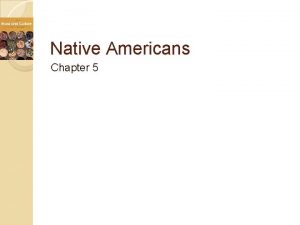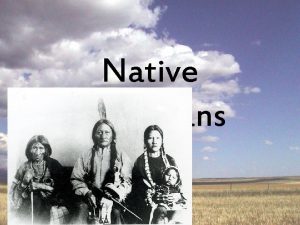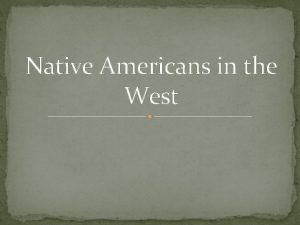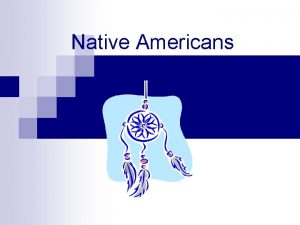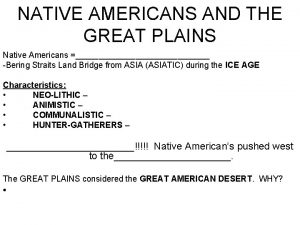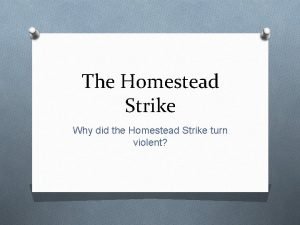INDUSTRIALIZATION Dawes Act Assimilate Native Americans Homestead Act























- Slides: 23

INDUSTRIALIZATION

Dawes Act – Assimilate Native Americans Homestead Act – Develop the land of the Great Plains


Factors for the rise of Industry • Natural Resources –water, timber, coal, iron, and copper • Located in the West • Railroads bring resources to the East

Factors for the rise of Industry Cont. • A large workforce – 1860 -1910 population tripled • Larger workforce greater demand for goods • Caused by: • Large Families • Flood of Immigrants (20 million between 1870 -1910)

Notion of Free Enterprise • Laissez-Faire – Belief that the government should not interfere in the economy. • Greater efficiency and wealth for everyone • Rise of Entrepreneurs – People who risk their capital in organizing and running a business.

THE RAILROADS

Linking the Nation • Railroad boom began in 1862 • Lincoln signed the Pacific Railway Act • Provided for the construction of a transcontinental railroad by two corporations: • The Union Pacific and the Central Pacific • To encourage rapid construction • Offered land for each mile of track laid

Who Built the Railroads? • Civil War veterans • Miners • Farmers • Ex-Convicts • New Immigrants from: • Ireland • China • Each crew had about 10, 000 employees each

Railroads Spur Growth • By linking the nation, railroads helped increase the size of markets for many products • Railroads stimulated the economy by spending a large sum of money on: • Steel • Coal • Timber


Land Grant System • To encourage railroad construction • Railroads sold the land they were given to settlers, real estate companies, and other businesses

Robber Barons • Great wealth • Accusations that they had built their fortunes by swindling investors and taxpayers, bribing government officials, and cheating on their contracts or debts • Robber Baron - a wealthy person who tries to get land, businesses, or more money in a way that is dishonest or wrong

Captain of Industry • Captain of Industry - a business leader that benefits the nation in a positive way

BIG BUSINESS

The Rise of Big Business • Dominated the economy, operating vast complexes of factories, warehouses, offices, and distribution facilities • Corporation - An organization owned by many people but treated by law as though it were a single person.

Trusts • Government became suspicious of large corporations • 1882 – Standard Oil (John D. Rockefeller) became first Trust • Trust – A new way of merging businesses that did not violate the laws against owning other companies

UNIONS

Working in the United States • Life was difficult for workers • Machines replaced skilled labor • Workers performed highly specific, repetitive tasks • Working conditions were unhealthy and dangerous • Breathed in lint, dust, and toxic fumes • In 1900 the average industrial worker made 22 cents per hour and worked an average of 59 hours a week. THAT IS ONLY $12. 98 PER WEEK!

Early Unions • Two types of Industrial Workers: • Craft workers – machinists, iron molders, glassblowers, shoemakers, printers • Common laborers – few skills, low wages • Craftworkers began to form Trade Unions • Unions limited to people with specific skills • Industry opposed unions • Companies would use a lockout to lock workers out of the property and refuse to pay them

The Struggle to Organize • Knights of Labor – The first nationwide industrial union. • In response to the railroad strike • 8 hour workday, a government bureau of labor statistics, equal pay for women, abolition of child labor creation of worker-owned factories

American Federation of Labor • Combination of Trade Unions • founded by Samuel Gompers • Belief that unions should stay out of politics • Higher wages, better working conditions in the American system

“Bread and Butter” • Bread and butter objectives • Better wages, better working conditions, shorter working hours
 Assimilation vs accommodation psychology
Assimilation vs accommodation psychology Assimilate mentally
Assimilate mentally What kind of food did the seminole tribe eat
What kind of food did the seminole tribe eat How many native americans died on the trail of tears
How many native americans died on the trail of tears Latinos and native americans seek equality
Latinos and native americans seek equality What three circumstances hurt native american
What three circumstances hurt native american Coahuiltecan tattoos
Coahuiltecan tattoos Native americans
Native americans Where did native americans come from
Where did native americans come from Dawes act
Dawes act Dawes severalty act of 1887
Dawes severalty act of 1887 Dawes serveralty act
Dawes serveralty act Dawes severalty act of 1887
Dawes severalty act of 1887 Wounded knee apush
Wounded knee apush Closing of the western frontier
Closing of the western frontier Why was homestead act important
Why was homestead act important Homestead act
Homestead act Chspee
Chspee Define soddies
Define soddies Push pull factors definition
Push pull factors definition Homestead act primary source
Homestead act primary source Mary dawes
Mary dawes Dawes plan
Dawes plan Internet en el mundo
Internet en el mundo



